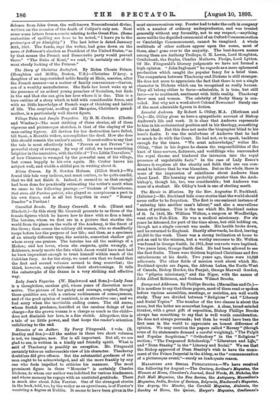A Kentish Country House. By Mary Adelaide, Lady Jennings. (Billory,
Guildford.)—The Hall-House at Hawkhurst was pur- chased by Mr. Nathaniel Collyer (1620-1700), grocer and citizen of London, about the year 1665 (it is supposed, by way of a refuge from the Plague), and was sold by a descendant in 1857. Nathaniel Lardner was born there in 1684, and died in 1768, being the son of Nathaniel Collyer's youngest daughter Hannah, by Richard Lardner, a Dissenting minister, first at Deal and after- wards in London. Nathaniel was the author of an Apologetic work, famous in its day, "The Credibility of the Gospel History," and his connection with the Hall-House is the most important event in its history. Lady Jennings tells us that this book cost him more than he ever received from it. He finally sold his interest in it for £150, hoping that its usefulness would be ex- tended if it became the publisher's interest to push its sale. There are various matters of interest in the family letters which Lady Jennings publishes. The earliest is a letter of con-
doleace from John Owen, the well-known Nonconformist divine, written on the occasion of the death of Collyer's only son. Next come some letters from a cousin relating to the Great Fire. (Some
curiosities of spelling are here to be noted, "I leave yu to the preteactyon of ye Almighty." ) The last letter is dated January 30th, 1601. The funds, says the writer, had gone down on the
news of Jefferson's election as President of the United States, "as by that means the French and Democratic party would prevail there." "The Duke of Kent," we read, "is certainly one of the most steady looking of the Princes."



































 Previous page
Previous page